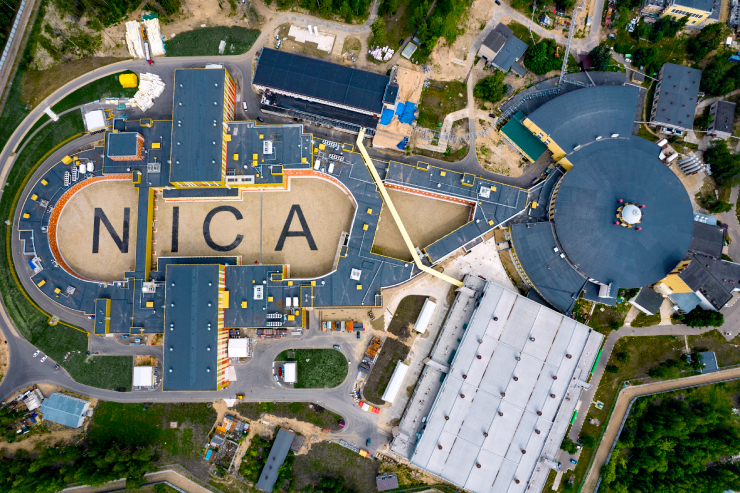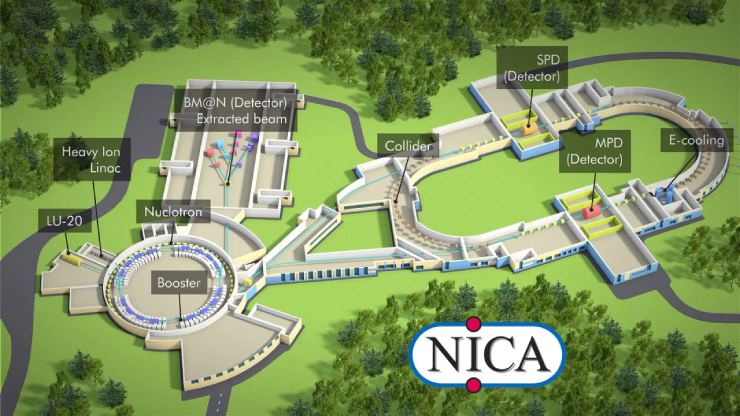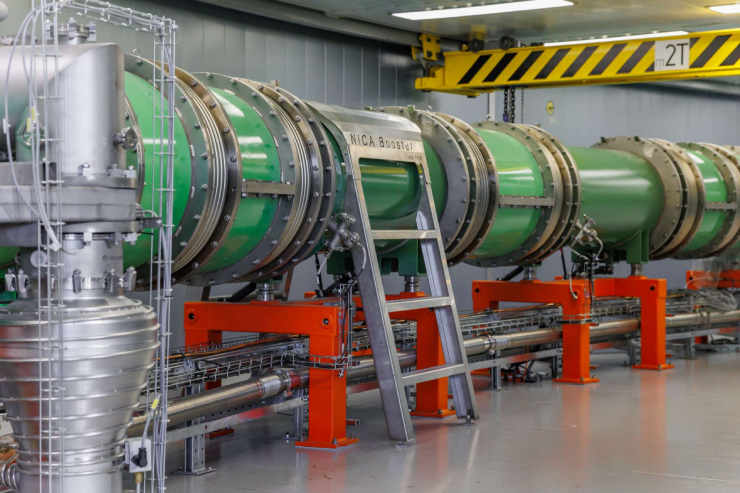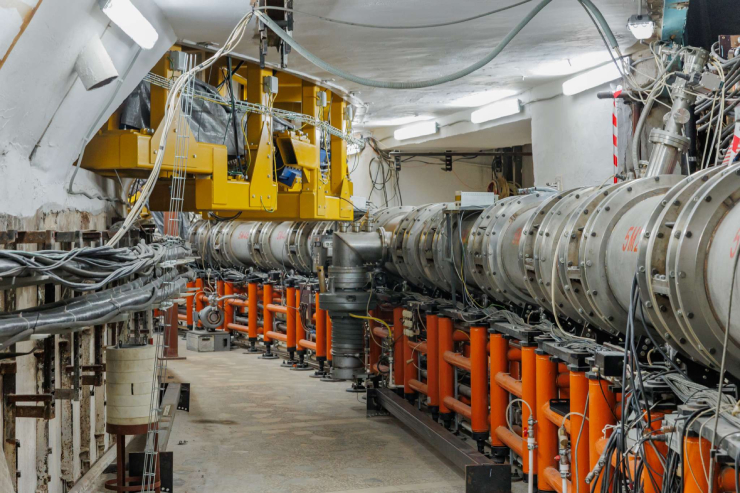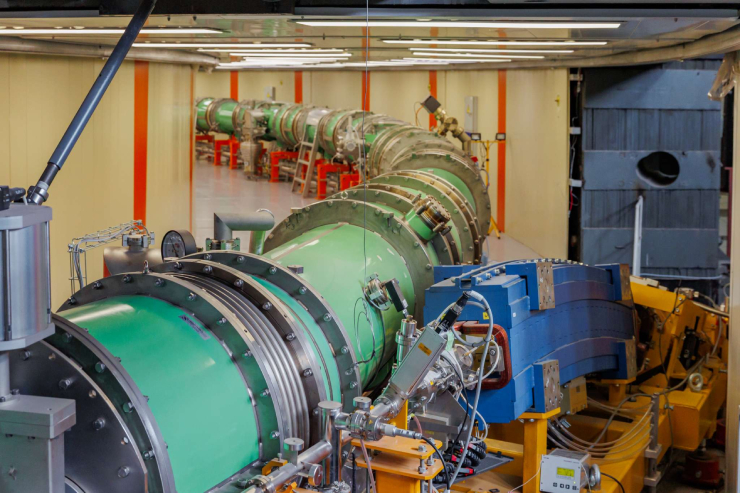Systems of ion beam transferring to Booster and Nuclotron: from design to first runs
News, 24 August 2023
At the Joint Institute for Nuclear Research, the construction of the NICA (Nuclotron based Ion Collider fAcility) accelerator complex for studying the properties of dense baryonic matter is being completed. Some of the equipment, including the systems for transferring ion beams to the Booster and Nuclotron synchrotrons, were designed and manufactured by employees of the JINR Laboratory of High Energy Physics together with colleagues from the Budker Institute of Nuclear Physics of SB RAS. Many years of work resulted in a series of publications, for which in 2022 a group of LHEP employees was awarded the JINR First Prize in the “Physics Instruments and Methods” category. The series contains more than 30 scientific papers devoted to the development of methods for beam injection into the Booster and Nuclotron, the creation of beam transport channels, commissioning, etc.
Unique NICA megascience project
The construction of the NICA accelerator complex is a huge and complex work that JINR scientists and engineers have been carrying out for many years. After the launch of the complex, scientists will be able to recreate in laboratory conditions the special state of matter in which our Universe was in the first moments after the Big Bang – the quark-gluon plasma, and study its properties. The complex under construction is a cascade of accelerators with a storage device at the last stage – the Collider. The complex is based on the superconducting synchrotron Nuclotron – this is the basic facility of the JINR Laboratory of High Energy Physics, operating since 1993, designed to produce beams of multiply charged ions with energies up to 4 GeV/n. In 2020, the new superconducting synchrotron Booster was launched – an accelerator designed on the basis of the Nuclotron technologies and leveraging the experience gained in the course of its construction and operation. The Booster equipment is being mounted in the magnet yoke of the legendary Synchrophasotron, a proton accelerator that operated from 1957 to 2002.
The beam begins in the ion source, where particles are born and, through electric fields, are “pulled” into the preaccelerator. In it, the beam is formed and transported to a linear accelerator, in which the particles acquire the required energy and are moved through the transport channels to the Booster. The Booster is a superconducting synchrotron that allows particles to be accelerated and not lost during the acceleration process before they enter the Nuclotron, since the major losses occur at low energies. Therefore, the Booster has high demands on the magnetic structure and vacuum level in the beam chamber. The Nuclotron in turn accelerates ions from the Booster to energies sufficient to conduct an experiment in the Collider. The collider, which is very similar in structure to the Booster and Nuclotron, has two rings converging at two meeting points. This allows the beams to move towards each other for a long time and interact with each other only where the apertures of the rings converge. In these areas, there are detectors that record the decay products of particles as a result of their interaction. There are two main detectors in the Collider: MPD (MultiPurpose Detector) and SPD (Spin Physics Detector).
Systems of ion beam transportation to the Booster and Nuclotron
For the Collider, the most important parameters of a heavy ion beam in the collision mode are its intensity and emittance (a numerical characteristic of an accelerated beam of charged particles, equal to the volume of phase space occupied by this beam), which together determine the Collider luminosity and luminosity lifetime. The design luminosity of the Collider (1027 sm-2∙s-1) and an acceptable luminosity lifetime (of the order of several hours) can be achieved using electronic and stochastic beam cooling systems in the Booster and Collider, but only under the condition that the intensity of the beam injected into the Collider is sufficient to accumulate the required number of ions, which is largely determined by the intensity of the beam accelerated in the Booster. Since the major losses of ions, according to experts, will be observed at energies below 5 MeV/n, the transport of ions from the ion source to the Booster with subsequent adiabatic capture of the beam in the acceleration mode is one of the most critical tasks in terms of obtaining the design beam intensity and luminosity of the NICA Collider. To carry out this and other tasks, systems for injection of ion beams into the Booster and Nuclotron, a system for the fast beam extraction from the Booster, as well as beam transport channels were created.
These systems have advanced functionality. “The beam injection system into the Booster, together with the transport channel, allows for beam injection by several alternative methods necessary to achieve the design intensity of the beam accelerated in the Booster,” says Alexey Tuzikov, Head of the LHEP Scientific and Experimental Department of Injection and Nuclotron Ring, “The beam transfer systems from the Booster to the Nuclotron serve to strip ions accelerated in the Booster to nuclei and transport them to the Nuclotron ring along the shortest trajectory with a minimal increase in beam emittances. The systems for beam injection into the Nuclotron and beam extraction from the Booster include two kicker magnets and a superconducting Lambertson magnet with non-standard designs and unique performance characteristics.”
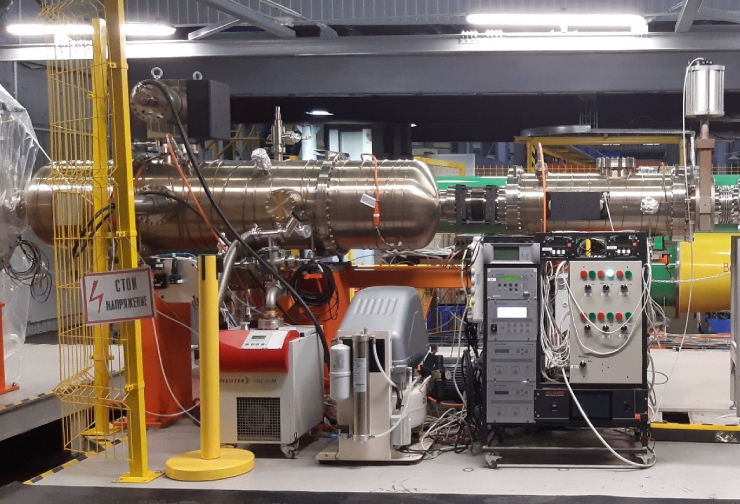 A section of the beam injection into the Booster
A section of the beam injection into the Booster
As the scientist notes, the joint work of specialists from JINR and the INP SB RAS on the creation of the beam extraction systems from the Booster and the beam transport channel to the Nuclotron began in 2016, when, based on the ideas presented by LHEP employees, the Institute of Nuclear Physics launched the technical implementation of the project. “The Booster – Nuclotron beam transport channel has a complex three-dimensional geometry, determined by the architectural features of the existing building and the relative position of the synchrotrons, therefore, it was of particular importance in the design to coordinate the channel geometry between the Booster and Nuclotron and numerically model the beam dynamics, which were carried out in close cooperation between the JINR LHEP’s and INP SB RAS’s staff. As a result, in the channel, in addition to implementing the basic functions of beam transfer, including its coordination with the receiving accelerator, the problems of compensating for the coupling of betatron oscillations at the channel output, as well as dumping ions with non-target charge onto the absorber were solved,” adds Alexey Tuzikov.
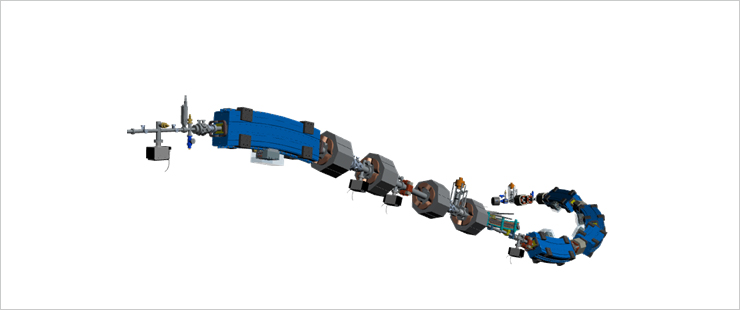 Beam transport channel from the Booster to the Nuclotron
Beam transport channel from the Booster to the Nuclotron
Commissioning run and the first physical run of the systems
The authors of the papers also describe the progress of the accelerator complex commissioning runs in 2020–2022. During the first three runs, conducted in December 2020, September 2021 and from January to April 2022, the Booster and beam transport channels were physically launched. “One of the main tasks of the first run was to cool the Booster to the required temperature and start the operating current. They were successfully completed,” says Artem Galimov, Chief Engineer of the injection complex of the LHEP accelerator complex, “During the run, the design vacuum level was achieved in the high-vacuum chamber of the accelerator, including in the devices of the beam injection system installed on it.”
In the first run, in the shortest time, on 19-29 December 2020, the injection and circulation of a beam of helium ions were obtained, and ions were accelerated to an energy of 100 MeV/n. “By the start of the second run, the main goals of which were to bring ion beams to the Nuclotron, the installation of the equipment for the Booster – Nuclotron beam transport channel and the system for fast beam extraction from the Booster ring, manufactured by the INP SB RAS, were completed,” says Alexey Tuzikov, “As a result of the subsequent work with ion beams, the Booster kicker magnet was successfully launched with a record level of magnetic field up to 2 kG and the beams with two types of ions — helium and iron — were extracted with the further transportation through the channel, in the final section of which the beams were detected.”
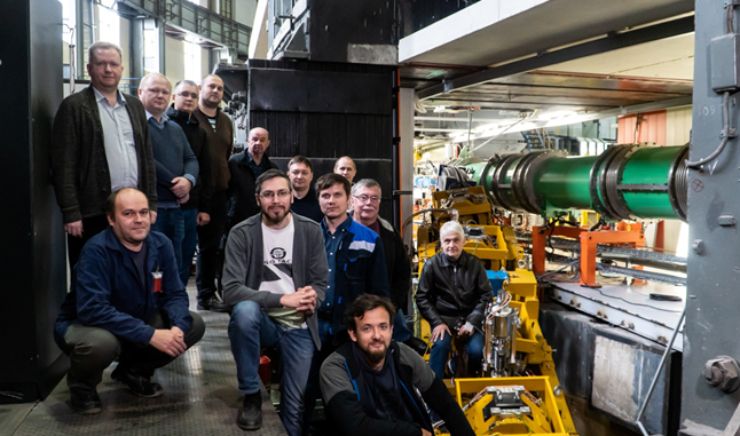 Joint team of JINR and the INP SB RAS during commissioning of the equipment for the system for fast beam extraction from the Booster and the transport channel
Joint team of JINR and the INP SB RAS during commissioning of the equipment for the system for fast beam extraction from the Booster and the transport channel
At the end of 2021, before the start of the third run, the system of heavy-ion beam injection into the Nuclotron was installed. “During the third run, we were already setting up the transfer of the beam from the Booster to the Nuclotron – and this was the first run when the entire system was simultaneously in operation,” says Artem Galimov, “Connecting the Booster to the Nuclotron is also not an easy task. If the beam passes immediately, this is a success, and if it does not pass, then long-term work begins to find the cause. In the third run, not without problems, we managed to do this, which later allowed us to carry out a full-scale run with heavy ions for physicists.”
During the third run, carbon ions were accelerated to an intermediate energy of 263 MeV/n and stripped to a bare nucleus. After being transported through the Booster – Nuclotron channel with an efficiency of about 75%, the carbon nuclei were introduced into the Nuclotron ring, accelerated and extracted to the SRC experimental facility.
By the end of 2022, during the physical start of the systems at the NICA accelerator complex, an important result was obtained: the first circulation of xenon ions in the Nuclotron ring in the history of the project. “The fourth commissioning run was a record in duration for the entire period of runs at the Nuclotron,” notes Alexey Tuzikov, “During it, in January 2023, the physical program of the NICA project was actually launched: an experiment was carried out at the BM@N installation on beams extracted from the Nuclotron. For the beam transfer systems to the Booster and Nuclotron, this run meant a lot, as it served as a serious resource test for the equipment of these systems, which was not without problems, but passed.”
Final stage of the project
The next year, 2024, should be the final year of the construction of the entire accelerator complex. The installation of the Collider itself, its numerous accompanying systems and beam transfer channels from the Nuclotron to the Collider must be completed. “When it’s done, it will be possible to conduct a run of cooling the magnetic cryostat system to the helium temperature, which will allow the operating current to be started,” says Artem Galimov, “This will have to be done carefully, since in the process a breakdown of superconductivity is possible, which is accompanied by a fast and large release of energy. The next task is to transfer the beam from the Nuclotron to the Collider through the channel, to show that the magnetic-optical structure of the ring is working, and the particles can be controlled.”
The construction of the unique NICA complex will not only allow us to gain new knowledge about the structure of nuclear matter, but also solve a number of applied tasks. The project will provide for the creation of an area where scientists and engineers will engage in practical research. One of its traditional lines is the study of the operation of electronics under severe radiation conditions. Such research is necessary not only to create electronics that operate close to reactors, but also for space flights. It is also planned to test biological objects for their resistance to radiation exposure and study how they change their properties. The launch of the channels and irradiation stations for applied research is also planned for 2024.
List of publications:
- A. Butenko et al. First experiments with accelerated ion beams in the Booster of the NICA accelerator complex // Proceedings of IPAC 2021, 2021.
- E. Syresin et al. NICA ion collider and plans of its first operations // Proceedings of IPAC 2022, 2022.
- A. Tuzikov et al. Beam transfer systems of NICA facility: from HILAC to Booster // Proceedings of RuPAC 2021, 2021.
- В.И. Волков и др. Концептуальный проект системы инжекции пучков тяжелых ионов в бустер ускорительного комплекса NICA // Письма в ЭЧАЯ, ISSN: 1814-5957, eISSN: 1814-5973, Изд: ОИЯИ, 11, 5(189), 1045-1067, 2014.
- В.В. Косухин, А.И. Сидоров, А.В. Тузиков, В.С. Швецов. Модуль устройств для инжекции пучка в Бустер ускорительного комплекса NICA // Письма в ЭЧАЯ, ISSN: 1814-5957, Изд: ОИЯИ, Россия, Дубна, 15, 7, 887-891, 2018.
- А.А. Фатеев и др. Высоковольтный импульсный источник питания инфлектора системы инжекции Бустера ускорительного комплекса NICA // Письма в ЭЧАЯ, ISSN: 1814-5957, eISSN: 1814-5973, Изд: ОИЯИ, 15, 7 (219), 892-895, 2018.
- O.V. Anchugov, D.A Shvedov, V.A. Kiselev et al. A Kicker Magnet for Beam Extraction from the Booster into the Booster–Nuclotron Beamline of the NICA Complex // Instrum Exp Tech 65, 474–481 (2022). https://doi.org/10.1134/S0020441222040029
- А.И. Сидоров, А.В. Тузиков, В.С. Швецов. Магнитный кикер для инжекции пучка в Нуклотрон ускорительного комплекса NICA // Письма в ЭЧАЯ, ISSN: 1814-5957, eISSN: 1814-5973, Изд: ОИЯИ, 17, 4 (229), 561-564, 2020.
